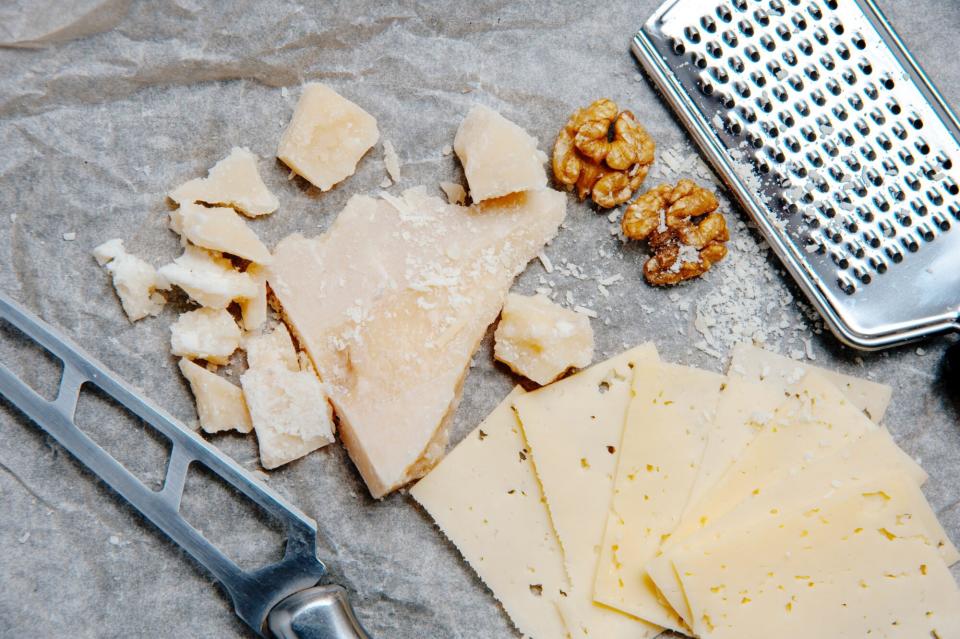The Parmesan Cheese in Your Fridge Is Likely Not the Real Thing—Here's How to Tell
We're lucky for the wide availability of Parmesan available to us in America. You can probably find this world-class cheese everywhere from your local Italian artisan grocer to the corner bodega. It can bring layers of aged creamy complexity and even notes of caramel and umami. But this ancient cheese also has a stunning range in quality. This range might be the most important thing to know about it: Not all Parmesans are the same. Amazingly, many aren't even Parmesan.
True Parmesan cheese is Parmigiano-Reggiano. This unpasteurized, cow's milk cheese has been made for centuries. By law, Parmigiano-Reggiano can only be made in one sector of the Italian region Emilia-Romagna. Here, farmers and cheesemakers do things the way they have been done since at least the Renaissance. Wheels that can surpass 80 pounds slowly age on long shelves in warehouse-like rooms, with the cheesemakers flipping wheels for even aging. Each year, millions of wheels become ready for export.

Getty Images
RELATED: Yes, Healthy Cheeses Exist—These Are The Best
Over time, Parmigiano-Reggiano has earned the nickname "the king of cheese." Right up with Nutella and olive oil, it's one of Italy's most vital exports. It's a pillar of Mediterranean cooking and, quietly, one of the great board-worthy cheeses you can find.
So how do you get the good stuff? Follow these four simple steps.
Avoid pre-grated Parmesans.
A pre-grated Parm likely isn't Parmigiano-Reggiano, but a lower-quality imitation. Also, grated cheese tends to dry out and lose something. Grating cheese yourself doesn't take long. With a wedge and a box grater or a Microplane, you can have freshly grated Parmesan in seconds—a cheese with far more flavor and life.
Look for "DOP" Parm.
Second, be sure your Parmigiano-Reggiano is DOP. DOP stands for Denominazione di Origine Protetta, a mark ensuring that a wedge or wheel comes from the right part of Italy and is made by the traditional methods. A pre-cut wedge's wrapping will likely reveal its DOP status. If you're buying cheese fresh off the wheel, you can ask whoever is doing the cutting.
Go straight to the source: the wheel.
Get Parmigiano-Reggiano sliced right from the wheel if you can. Not only is it mildly thrilling to watch a cheesemonger knock a small wedge free, but your wedge will also be fresher. In a way, the cheese starts to die when removed from its wheel. You might as well keep yours as lively as you can. Look for big wheels of Parmesan at better grocery stories and specialty shops.
Consider your preferences for aging.
Do you prefer a younger or older cheese? Parmigiano-Reggiano aged 18 months is different from cheese aged three years. The 18-month Parm will have more milkiness; the older cheese will be sharper and spicier, with more low-toned barnyard and caramel nuances.
How to store Parmigiano-Reggiano? Put it in a simple, sealable bag or plastic container. No need for fancy cheese paper.
Another incredible thing about Parmigiano-Reggiano—other than how great it is with a dry white wine, like Prosecco—is the variety within the category. There are hundreds of Parmigiano-Reggiano producers working within the designated area of Emilia Romagna. A mountain range traverses the region, meaning cows graze at different altitudes. These cows snack on different forage. They are milked at different times of the year. And DOP rules only require 75% of forage to be from land within the certified area, meaning there's wiggle room on what cows can eat. All of these factors can result in slight variations.
That said, the quality of this "king of cheese" won't vary if you find a genuine wedge. Some families making Parmigiano-Reggiano have refined their methods over six or seven generations, some more. Knowing how to tap into this mastery can only make your eating better.

